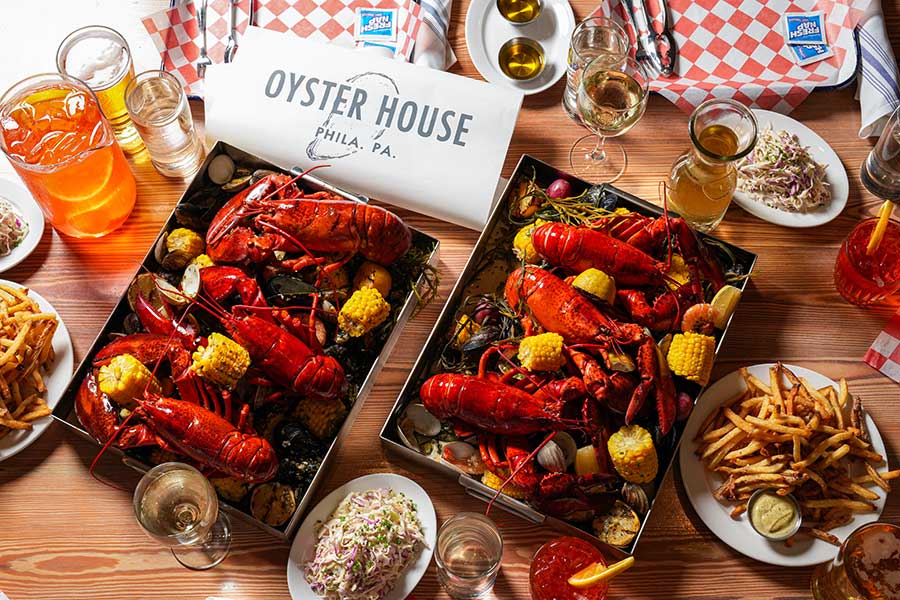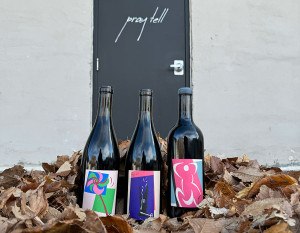Meet the Chef Duo Creating Seafood Synergy at Oyster House
Chefs Joe Campoli and James Waters have held many roles within Oyster House’s kitchen — including being each other’s bosses.

Oyster House chef de cuisine James Waters (left) and executive chef Joe Campoli / Photograph by Mike Prince
Behind the Line is Foobooz’s interview series with the people who make up Philly’s dynamic food and beverage scene. For the complete archives, go here.
Neighborhood institutions like Oyster House have a choice: they can either stay the same and remain a nostalgic anchor for generations of diners craving consistency, or go the riskier route and attempt to keep up with the times. Oyster House has somehow excelled at both.
For over 40 years (and three generations of owners), it has remained one of Philadelphia’s most beloved seafood restaurants — one where you can feast on dishes deeply rooted in our region’s culinary history like snapper soup and fried oysters with chicken salad (a fan favorite in Philly since the Colonial era), or order from an ever-changing menu of inventive takes on seafood plates.
Perhaps the key to walking the line between carrying on a legacy and staying relevant is having people who grow with the restaurant. Or at least that’s what I’ve gleaned from my conversation with executive chef Joe Campoli and chef de cuisine James Waters who, in the spirit of their collaborative work, wanted to do this interview together. They both have spent a large part of their culinary careers working at Oyster House, and at one point, Waters was actually Campoli’s boss. Regardless of titles, they both agree that they’re always learning something new from each other and from the staff on their team.
Here, they talk about what they love about seafood, why they prefer East Coast oysters to West Coast oysters, and what goes into the Oyster House mirepoix.
How did you end up at Oyster House?
Joe: I was roughly 18 years old and still in high school when I started as a dishwasher at Gallo’s Seafood on the Boulevard. I got into catering after that. Then I worked at the Churchville Inn and became the sous chef there before coming to Oyster House. I started here as a line cook seven years ago and I worked my way up from there. Now I’m the executive chef.
James: I went to culinary school right after high school. I was a kid that didn’t have much direction, and my parents didn’t want to let me live at home rent-free, so culinary school was the best choice. I started working at Oyster House as a sous chef in 2013, and Joe was actually a line cook. I was his boss way back when. I left in 2015 and moved to the West Coast. My wife got pregnant so we came back to be with our families in 2022, and I was brought back on as the chef de cuisine.
Wait, you were Joe’s boss and now he’s your boss? Seems like the tables have turned! How does that make you feel?
James: It feels great. Joe always had this great energy. Being in this industry, you come across people and you’re like, “Okay, he knows what’s going on, he’s bright.” It was a pleasure for me not only working with him back then, but after I left, it was amazing following his Instagram and seeing his growth. It’s not often that somebody sticks with the same restaurant and works their way up through the ranks, especially today. Seeing him do that — seeing him become the executive chef — was like a proud big brother moment. And then being able to come back and work under his leadership has been amazing. It’s been phenomenal. It’s nice working somewhere where we can learn from one another. I still feel like I can teach him a few things, and he can teach me a few things as well. So, it really has been a great full circle experience.
Joe, what’s it like being James’ boss now?
Joe: To be honest, we never expected it. I heard he was coming back to Philly. I knew he was having a kid. I also have a kid, so it’s nice to be able to relate to one another in that respect. James already knew how things run and I knew he could run the restaurant without me. Once I heard he was coming back to Philadelphia, I was like “He needs to be back on my team.”
James, why did you want to come back to Oyster House when you moved back to Philly?
James: It’s just such a great family environment here. On the West Coast I worked in other places, but I would often feel nostalgic for the camaraderie that the owner, Sam Mink, cultivates here. It’s just a great team. I’ve been in the industry long enough to recognize how valuable that is and it’s not something that you find everywhere.

For $55 per person (minimum of six people) you can get the Lobster Party, steamed Maine lobster, shrimp, clams, mussels, potatoes, corn, slaw, and fries for the table. Just give Oyster House a 48 hour heads up! / Photograph by Mike Prince
Oyster House is a Philly institution, and even though it’s been around for over 40 years, the menu stays fresh. Every time I go there’s always some wild, new dish to try. So how do you balance that line between holding up the traditional classics while also being innovative and making new dishes to draw diners in?
Joe: There are so many go-to dishes – like the lobster roll, the crab cake, fisherman’s stew, fried oysters and chicken salad – that are the comfort foods people come here for. We try to keep that as consistent as possible. But what’s fun is that we are allowed to change the menu. We have a lot of freedom.
James: Creatively, we get the opportunity to put dishes on the menu that are sometimes a bit out there, but we bring them out to the lineup anyway, and we have productive conversations with the staff about them. Sometimes the dishes miss the mark but with feedback from the team, we’re able to get back in the kitchen, improve it and make little adjustments, and end up making a great dish that everyone has had the opportunity to help develop.
What’s the best part about working with seafood?
Joe: My biggest thing with seafood is you can incorporate so much different flavor into it. Fish holds up very well to different flavors, especially the oilier fishes and the meatier fishes. There are just so many ways to prepare fish, in my opinion, whereas with meat, I feel like it’s pretty streamlined.
James: Oyster House has built so many relationships with different fish vendors and with the actual people bringing the fish onto the docks, or in some cases, the farmers when you’re talking about oysters and whatnot. So being able to lean into that, from a chef’s standpoint is, it’s just second to none. It gives us the opportunity to practice what we love to do. It’s exciting to have rotating fish on the menu and become more in tune to with what’s available from season to season.
When it comes to building new recipes, do you have a signature move or signature ingredient?
Joe: Shallots, garlic, and green Thai chili. I feel like that’s the Oyster House mirepoix.
What is the best way to enjoy raw oysters? Do you like adding sauces or do you just throw them back plain?
Joe: I throw them back plain. I’m not a huge West Coast oyster fan. I’m an East Coast oyster lover — the brininess and saltiness. They’re also not that creamy, which is what I liked the most about them. West Coast oysters are very creamy — they’re just a big mouthful for me.
James: I pretty much agree with Joe there. I will say that I sometimes do like a little bit of lemon on mine though. But for the most part, I’m an East Coast oyster guy. You know, I feel like the brininess speaks to the East Coast attitude a little bit more versus the smooth and butteriness of that laid back California or West Coast vibe.
What’s something first timers must try when they come to Oyster House?
Joe: It’s hard to pick just one dish because we change them so much. As of right now, if you were to ask me, I would do the the tuna crudo, the octopus, and the whole fish. The selling point for the whole fish is that it’s a whole fish. It’s French cut, there are no bones in it, so you can eat the whole thing head to tail.
What are some plans you have for Oyster House in 2024?
Joe: Honestly, we haven’t talked much about the new year, but I know we want to do a lot more collaboration dinners. We just started doing that. We started with Sweet Amalia. We also did one with Ange Branca of Kampar. That’s probably what we’re looking forward to the most.


